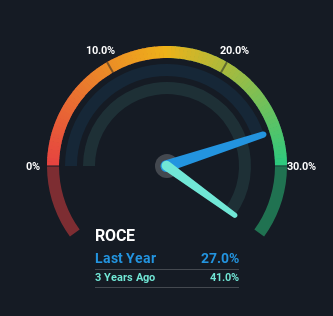If we want to find a potential multi-bagger, often there are underlying trends that can provide clues. Amongst other things, we'll want to see two things; firstly, a growing return on capital employed (ROCE) and secondly, an expansion in the company's amount of capital employed. If you see this, it typically means it's a company with a great business model and plenty of profitable reinvestment opportunities. And in light of that, the trends we're seeing at SFD's (WSE:SFD) look very promising so lets take a look.
What Is Return On Capital Employed (ROCE)?
If you haven't worked with ROCE before, it measures the 'return' (pre-tax profit) a company generates from capital employed in its business. To calculate this metric for SFD, this is the formula:
Return on Capital Employed = Earnings Before Interest and Tax (EBIT) ÷ (Total Assets - Current Liabilities)
0.27 = zł15m ÷ (zł101m - zł48m) (Based on the trailing twelve months to June 2023).
Thus, SFD has an ROCE of 27%. In absolute terms that's a great return and it's even better than the Retail Distributors industry average of 13%.
Check out our latest analysis for SFD

Historical performance is a great place to start when researching a stock so above you can see the gauge for SFD's ROCE against it's prior returns. If you want to delve into the historical earnings, revenue and cash flow of SFD, check out these free graphs here.
What Does the ROCE Trend For SFD Tell Us?
The trends we've noticed at SFD are quite reassuring. The numbers show that in the last five years, the returns generated on capital employed have grown considerably to 27%. The amount of capital employed has increased too, by 261%. This can indicate that there's plenty of opportunities to invest capital internally and at ever higher rates, a combination that's common among multi-baggers.
One more thing to note, SFD has decreased current liabilities to 47% of total assets over this period, which effectively reduces the amount of funding from suppliers or short-term creditors. This tells us that SFD has grown its returns without a reliance on increasing their current liabilities, which we're very happy with. Nevertheless, there are some potential risks the company is bearing with current liabilities that high, so just keep that in mind.
What We Can Learn From SFD's ROCE
To sum it up, SFD has proven it can reinvest in the business and generate higher returns on that capital employed, which is terrific. And with the stock having performed exceptionally well over the last five years, these patterns are being accounted for by investors. With that being said, we still think the promising fundamentals mean the company deserves some further due diligence.
On a separate note, we've found 1 warning sign for SFD you'll probably want to know about.
If you want to search for more stocks that have been earning high returns, check out this free list of stocks with solid balance sheets that are also earning high returns on equity.
New: Manage All Your Stock Portfolios in One Place
We've created the ultimate portfolio companion for stock investors, and it's free.
• Connect an unlimited number of Portfolios and see your total in one currency
• Be alerted to new Warning Signs or Risks via email or mobile
• Track the Fair Value of your stocks
Have feedback on this article? Concerned about the content? Get in touch with us directly. Alternatively, email editorial-team (at) simplywallst.com.
This article by Simply Wall St is general in nature. We provide commentary based on historical data and analyst forecasts only using an unbiased methodology and our articles are not intended to be financial advice. It does not constitute a recommendation to buy or sell any stock, and does not take account of your objectives, or your financial situation. We aim to bring you long-term focused analysis driven by fundamental data. Note that our analysis may not factor in the latest price-sensitive company announcements or qualitative material. Simply Wall St has no position in any stocks mentioned.
About WSE:SFD
SFD
Engages in the wholesale and retail of nutrients, dietary supplements, and sports accessories in Poland.
Adequate balance sheet with slight risk.
Market Insights
Community Narratives




